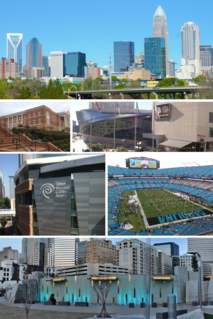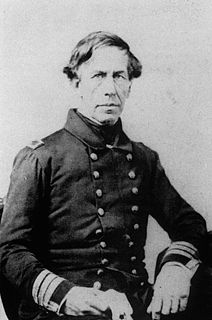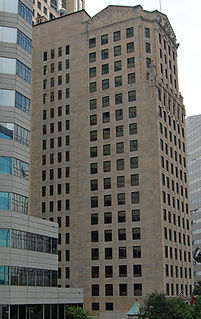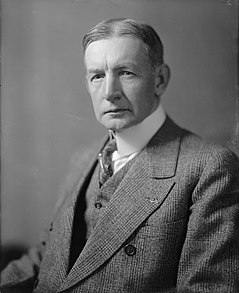
Charles Gates Dawes was an American banker, general, diplomat, and Republican politician who was the 30th vice president of the United States from 1925 to 1929. For his work on the Dawes Plan for World War I reparations, he was a co-recipient of the Nobel Peace Prize in 1925.
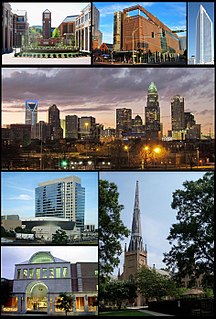
Mecklenburg County is a county located in the southwestern region of the state of North Carolina, in the United States. As of the 2010 census, the population was 919,618. It increased to 1,034,070 as of the 2015 estimate, making it the most populous county in North Carolina and the first county in the Carolinas to surpass 1 million in population. Its county seat and largest city is Charlotte.

Washington is the county seat of Wilkes County, Georgia, United States. Under its original name Heard's Fort, it was briefly the state capital, and is noted as the place where the Confederacy voted to dissolve itself, effectively ending the American Civil War. The population was 4,295 at the 2000 census. The city is often referred to as Washington-Wilkes, to distinguish it from other places named Washington.

The Bank of America Corporate Center is an 871 ft (265 m) skyscraper in Uptown Charlotte, North Carolina. When completed in 1992, it became and still is the tallest building in Charlotte and in North Carolina; the building is 60 stories high. It is the 174th-tallest building in the world. Designed by Argentine architect César Pelli and HKS Architects, it is the 31st-tallest building in the United States and is the most widely known building in the Charlotte skyline. It is best known as the world headquarters for Bank of America.
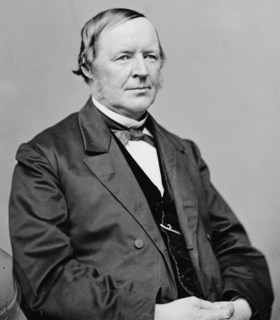
Hugh McCulloch was an American statesman who served two non-consecutive terms as U.S. Treasury Secretary under three presidents. He was opposed to the National Banking Act of 1864, and attempted to bring the United States back to the gold standard throughout his career.
NationsBank was one of the largest banking corporations in the United States, based in Charlotte, North Carolina. The company named NationsBank was formed through the merger of several other banks in 1991, and prior to that had been through multiple iterations. Its oldest predecessor companies had been Commercial National Bank (CNB), formed in 1874, and American Trust Company founded in 1909. In 1998, NationsBank acquired BankAmerica, and modified that better-known name to become Bank of America.

Uptown Charlotte is the central business district of Charlotte, North Carolina. The area is split into four neighborhoods (wards) by the intersection of Trade and Tryon Streets, and bored by Interstate 277 and Interstate 77. Uptown Charlotte is the largest business district in Charlotte, and the Carolinas.

Hugh L. McColl Jr. is a fourth-generation banker and the former Chairman and CEO of Bank of America. Active in banking since around 1960, McColl was a driving force behind consolidating a series of progressively larger, mostly Southern banks, thrifts and financial institutions into a super-regional banking force, "the first ocean-to-ocean bank in the nation's history."
Citizens and Southern National Bank (C&S) began as a Georgia institution that expanded into South Carolina, Florida and into other states via mergers. Headquartered in Atlanta, Georgia; C&S merged with Sovran Bank in 1990 to form C&S/Sovran in hopes of fending off a hostile takeover attempt by NCNB Corporation. Only a year later, however, C&S/Sovran merged with NCNB to form NationsBank. Both are now part of the modern day Bank of America.

The Levine Museum of the New South, is a history museum located in Charlotte, North Carolina whose exhibits focus on life in the North Carolina Piedmont after the American Civil War. The museum includes temporary and permanent exhibits on a range of Southern-related topics.

200 South Tryon is a 299 feet (91 m) tall skyscraper in Charlotte, North Carolina. It was completed in 1961 and has 18 floors. It is the 19th tallest building in the city. Gerald D. Hines Interestspurchased what was then called the BB&T Building in December 1998 and began a renovation process that added another floor which was completed in 2001. and in the process was upgraded to contain all Class B office space.

James Addison Jones, was the founder of J.A. Jones Construction, as well as being a known philanthropist for many organizations such as the Methodist Church, the city of Charlotte, North Carolina and surrounding areas, regional hospitals, and several other companies. He was the benefactor and namesake for the James Addison Jones Library at Greensboro College and the J.A. Jones Library at Brevard College. His company was also responsible for the assistance of the building of the Liberty fleet during World War II. Jones was married four times in his lifetime and had fifteen children.

Events from the year 1865 in the United States. The American Civil War ends with the surrender of the Confederate States, beginning the Reconstruction era of U.S. history.
Southern National Bank was a bank headquartered first in Lumberton, North Carolina and then in Winston-Salem, North Carolina. It joined with BB&T in 1995.

Rufus Lenoir Patterson was an American businessman and politician from North Carolina. Born into a prominent family, Patterson received private schooling before matriculating at the University of North Carolina. Electing to forgo a career in law, Patterson studied in a banking house and founded a series of mills in Salem, North Carolina. He served on the county court and was elected to a term as Mayor of Salem. Patterson was twice a delegate to state constitutional conventions. He was the father of Rufus Lenoir Patterson Jr.
Rogers Caldwell was an American businessman and banker from Tennessee. He was known as the "J. P. Morgan of the South." He was the founder and president of Caldwell and Company and its subsidiary, the Bank of Tennessee. He was the president of the Tennessee Hart-Parr Company, which sold tractors in the Southern United States, mechanizing agriculture, and the president of the Kentucky Rock and Asphalt company, which built infrastructure and roads in Tennessee. With his friend and business associate politician Luke Lea, he owned newspapers in Tennessee.
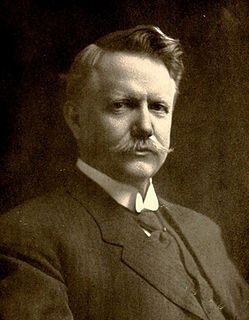
Francis Henry Fries was an American textile businessman and industrialist from North Carolina.
